Introduction to Social Network Research: Brokerage Typology?
Social network analysis (SNA) is a set of concepts and tools that can help Extension professionals analyze the situation before delivering a program and then leverage the connections in the network to enhance their impact. This publication is the third in a three-part EDIS publication series introducing social network analysis concepts. Introduction to Social Network Research: General Introduction and Major Terminology (https://edis.ifas.ufl.edu/wc195) defines networks and the variables used to describe them. Introduction to Social Network Research: Application of Social Network Analysis in Extension (https://edis.ifas.ufl.edu/wc196) discusses the concept of social network analysis and how it can be used in Extension. This publication focuses on brokerage and brokerage typology. Brokerage is one of the important variables considered in social network studies.
Brokerage can be defined as connecting two separate areas of a network, and this concept has practical applications for cooperative Extension. With an understanding of brokerage, Extension educators can identify where gaps exist in the outreach of Extension and which stakeholders are filling or able to fill these gaps. For example, consider an Extension educator who wants to deliver a financial management program in two neighborhoods, A and B, in Alachua County. Of these two neighborhoods, Neighborhood B requires immediate help with financial management. The educator has connections to Neighborhood A but has no connections in Neighborhood B. The Extension educator knows that a family in Neighborhood A is connected to Neighborhood B by having some friends in Neighborhood B. In this example, the educator can take advantage of the Neighborhood A family's (broker family) connections to make new connections and deliver a program in Neighborhood B.
Brokerage
Brokerage is a state or situation in which an actor connects otherwise unconnected actors or fills gaps or network holes in the social structure (Burt, 1992; Gould & Fernandez, 1989). In Figure 1 the broker is represented by the black circle, which fills the gap or connects actors who were previously not connected to each other directly, represented by the white circles.

Credit: Adapted from Kumar Chaudhary (2014, p. 24)
The broker may connect separate areas of a network socially, economically, or politically, and therefore he/she is the only one to access both valued information and resources from different areas of the network (Stovel, Golub, & Milgrom, 2011). Brokerage is the only mechanism which allows isolated or unconnected actors to share information and resources and to interact economically, politically, and socially (Stovel & Shaw, 2013). One example would be a big box store connecting producers and consumers economically.
Due to his or her connections to and control over unique information/resources between unconnected actors, an actor who serves as a broker in the network has more access to information and resources compared to those who are not brokers (Burt, 1992; Yin, Wu, & Tsai, 2012). Brokers may benefit from this control over information/resources, may become more influential and powerful in the network, and may have increased efficiency in their work (Fernandez & Gould, 1994; Stovel & Shaw, 2013).
To further categorize brokerage, Gould and Fernandez (1989) introduced the concept of brokerage typology. This typology divides brokerage into five types based on the direction information/resources flow in the network and divides actors into mutually exclusive groups, classes, or organization of actors. Examples of groups or organizations that may be connected through brokerage are two different communities such as producers and consumers, Extension administrators and Extension educators, or two departments at the University of Florida. The types of brokers are liaison, itinerant, coordinator, gatekeeper, and representative. It is important for Extension educators to understand the different types of brokerage in order to identify the broker in a given situation and how information is flowing among unconnected actors. Definitions for these brokerage types follow.
Liaison: In liaison brokerage the broker is a liaison between two different groups to which he or she does not belong (Fernandez & Gould, 1994; Gould & Fernandez, 1989). In Figure 2 the broker (B) connects two groups, A and C, but is not part of either group. One example of liaison brokerage is when a middleman, such as an Extension educator, connects researchers within the University of Florida to the general public through the dissemination of research. The Extension educator, researchers, and the general public form three distinct groups, and information moves from researchers to general public via the Extension educator. The resource/information flow in this brokerage example is new information discovered by researchers which in turn helps address issues faced by society.
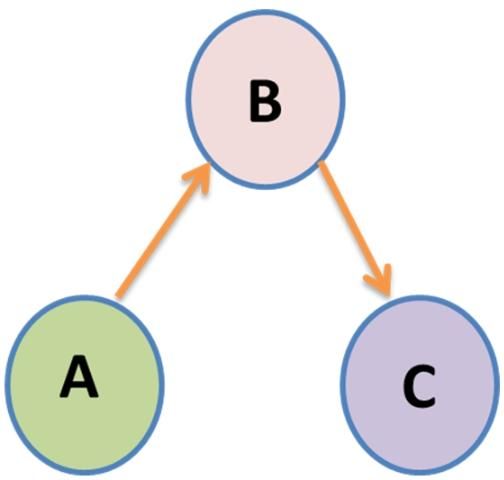
Credit: Adapted from Gould and Fernandez (1989, p.93)
Itinerant: In this brokerage type two unconnected actors (A and C) belong to one group while the broker (B) belongs to a different group (Figure 3) (Fernandez & Gould, 1994; Gould & Fernandez, 1989). Itinerant brokerage is also called consultant brokerage because the broker acts as a consultant to both unconnected actors of same group. An example of itinerant brokerage is the Extension educator who helps to connect farmers and consumers in the same community through a Buy Local program. The resource/information flow in this brokerage example is information related to buying locally grown food, and Extension educator shares this information via the Buy Local program.
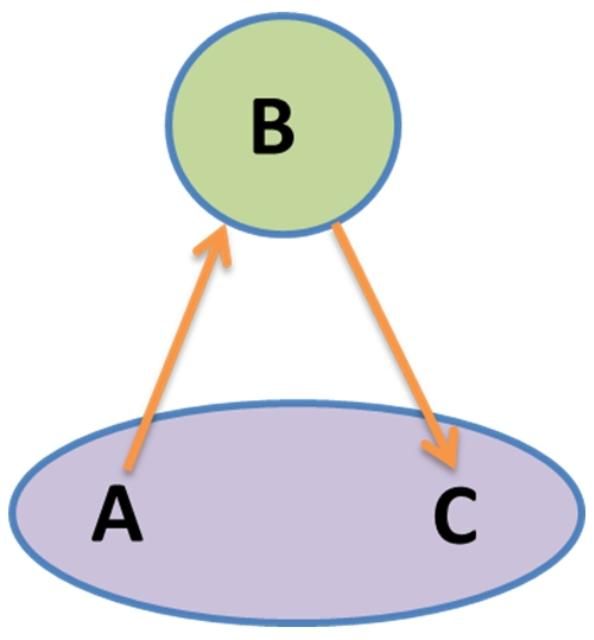
Credit: Adapted from Gould and Fernandez (1989, p.93)
Coordinator: In coordinator brokerage all three actors (A, B, and C) belong to the same group and brokering happens within the group (Figure 4) (Fernandez & Gould, 1994; Gould & Fernandez, 1989). An example of this kind of brokerage is among the members of a county Extension office, where one member in the office connects two other members who would not otherwise communicate with each other regarding topics such as how to deliver a specific program more efficiently and how to develop useful evaluation questions. The resource/information flow in this brokerage example is communication among members in the office.
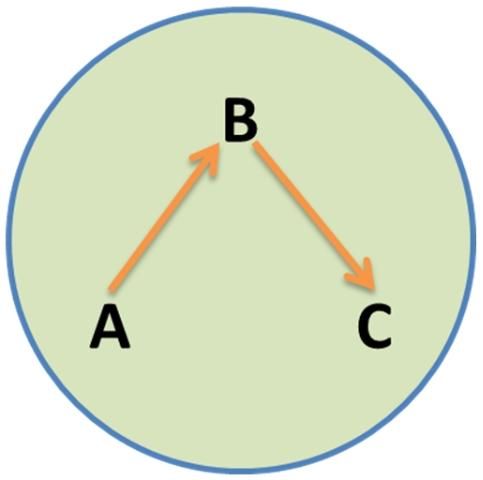
Credit: Adapted from Gould and Fernandez (1989, p.93)
Gatekeeper: In this brokerage type the broker (B) and one of the two unconnected actors (C) belong to one group while another unconnected actor (A) belongs to a different group. The broker in this type controls incoming information/resources to his/her group and makes decisions about whether or not the unconnected actors in the group have access to information or resources (Figure 5) (Fernandez & Gould, 1994; Gould & Fernandez, 1989). One example of this kind of brokerage would be a Homeowner Association (HOA) manager, who may control Extension agents' access to the community for environmentally friendly landscaping programs. The manager and residents belong to one group (the HOA) to which the Extension agent is not connected. The resource/information flow in this brokerage example is the information about best landscaping practices from Extension agents.
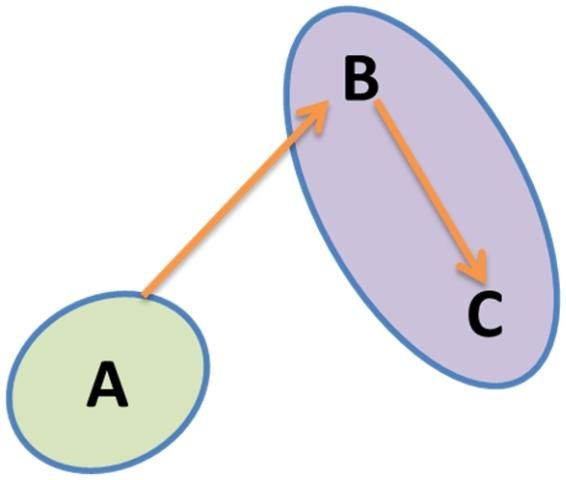
Credit: Adapted from Gould and Fernandez (1989, p.93)
Representative: This type of brokerage is similar to gatekeeper brokerage, as the broker (B) and one unconnected actor (A) belong to one group while the other unconnected actor (C) belongs to another different group (Figure 6), but the direction of the flow of information or resources is different. In this brokerage type the broker represents his/her group for any kind of negotiations with the outside group (Fernandez & Gould, 1994; Gould & Fernandez, 1989). An example of representative brokerage would be a farming community where there is an outbreak of a pest problem and the local Extension office in the county is unaware of that outbreak. A local leader in the community would act as a broker when he or she informs the county Extension office about the educational needs of the farmers for managing the pest problem. The resource/information flow in this brokerage example is awareness of the need for a prevention and management program from the local leader to the county Extension office.
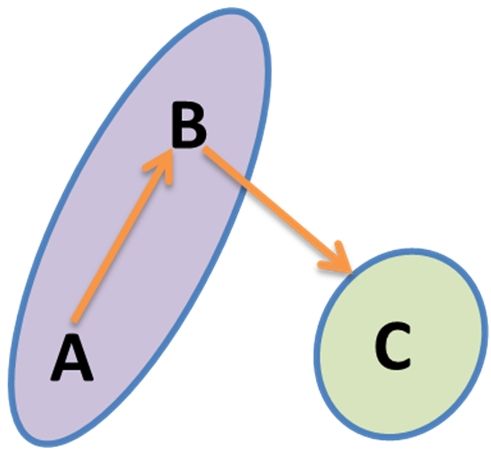
Credit: Adapted from Gould and Fernandez (1989, p.93)
Conclusion and Recommendations for Extension
Brokerage is a very powerful concept used in network studies. Brokerage occurs constantly in our daily lives. A common example where the term is explicitly used is when we use a broker to negotiate the deal between buyers (us) and the seller when buying property. The brokerage typology discussed in this publication provides details to aid in understanding the brokerage concept. The idea of brokerage and specifically the brokerage typology have many practical implications in Extension programming as well as in our daily lives. Specifically, Extension educators can take advantage of this typology to understand how information/resources flow among their target audiences. Extension educators may use the understanding of this flow of information/resources and the association of actors in subgroups to improve their programming and communication efforts.
It is recommended that Extension educators identify brokers who can connect two otherwise unconnected target audiences in order to design and deliver Extension programs together for similar stakeholders. Using an understanding of brokerage relationships, educators also can identify the brokers in their local communities to increase the connectedness of communities and increase the reach of Extension programs to a larger population. To identify brokers in Extension teams or stakeholders, Extension educators should first observe interactions and conduct informal discussions about connections of an individual or group to outside unconnected individuals or group. Another method that can be used to identify brokers is to conduct SNA with a group or network of interest.
Among all five distinct types of brokerage, the gatekeeper and representative brokers are in the most advantageous position, as they perform information/resources processing to their groups and external representation of their group by playing the boundary-spanning or gap-filling roles (Fernandez & Gould, 1994; Gould & Fernandez, 1989). Extension educators have to identify the various unconnected groups around them and then identify the broker. With an understanding of brokerage, Extension educators can improve connections among target audiences, members in the Extension office, and researchers and administrators at the university and can serve the general public in a more efficient way.
References
Burt, R. S. (1992). Structural holes: The social structure of competition. Cambridge, MA: Harverd University Press.
Fernandez, R. M., & Gould, R. V. (1994). A dilemma of state power: Brokerage and influence in the national health policy domain. American Journal of Sociology, 99(6), 1455–1491.
Gould, R. V., & Fernandez, R. M. (1989). Structures of mediation: A formal approach to brokerage in transaction networks. Sociological Methodology, 19, 89–126.
Kumar Chaudhary, A. (2014). Diversity and reach of Penn State Extension programs and effect of brokerage and network position on extension program outcomes through Social Network Analysis (SNA) (Unpublished master's thesis). The Pennsylvania State University, State College, PA.
Stovel, K., Golub, B., & Milgrom, E. M. M. (2011). Stabilizing brokerage. Proceedings of the National Academy of Sciences, 108 (Supplement 4), 21326–21332.
Stovel, K., & Shaw, L. (2013). Brokerage. Annual Review of Sociology, 38, 139–158.
Yin, X., Wu, J., & Tsai, W. (2012). When unconnected others connect: Does degree of brokerage persist after the formation of a multipartner alliance? Organization Science, 23(6), 1682–1699.


